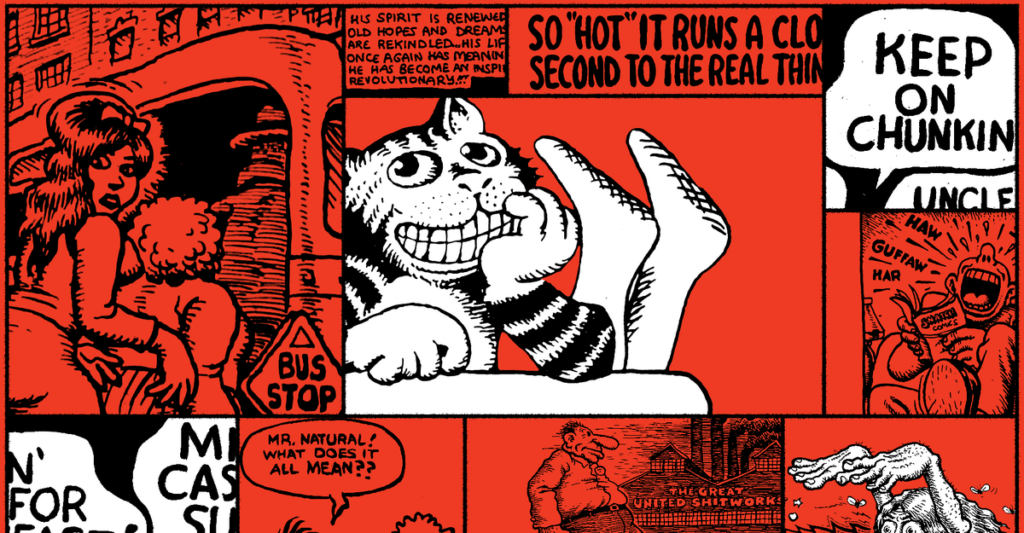How R. Crumb Tapped Into America’s Screwy Id

Sure nice artists are synonymous with their kinks. Egon Schiele had his factor for gaunt women and their undergarments. Robert Mapplethorpe was keen on bulging muscle groups wrapped in leather-based. After which there’s the legendary cartoonist R. Crumb—lover of strong legs, worshipper of meaty thighs, champion of the ample bottom. To really know his artwork is to know what turns him on.
For the person who successfully invented underground comics within the Nineteen Sixties, rubbing his readers’ faces in his sexual proclivities was all the time the purpose. If Crumb, now 81, was helpless in opposition to his personal needs—and there he was on the web page, quivering and sweating behind his thick glasses as he beheld one among his zaftig goddesses—he suspected that, by some means, everybody else was additionally helpless in opposition to theirs. His comix, as he renamed them, epitomized the hippie flip of the last decade as a result of he dove to the depths not simply of his personal unconscious, however of one thing collectively screwy, mentioning all of the American muck.
He was the anti–Norman Rockwell the tradition was craving. However this was additionally the gamble of his artwork. Diving down like that, he risked derision—being known as a sicko, a misogynist, a racist (all labels he certainly couldn’t escape).
In a loving biography, Crumb: A Cartoonist’s Life, Dan Nadel begins with a childhood reminiscence that Crumb preserved in a 2002 comedian, “Don’t Tempt Destiny.” A slouchy younger Crumb is standing in a junkyard subsequent to a boy who’s hurling items of cement over a cinder-block wall. Crumb is appalled by the “whole obliviousness” of the boy, who doesn’t care that he would possibly actually damage somebody. To reveal the hazard, Crumb then does “the loopy factor” and walks to the opposite aspect of the wall, the place a bit instantly hits him within the mouth, knocking out a entrance tooth with an ideal comic-book “BAM!” The crux of Crumb, Nadel writes, might be discovered on this anecdote, the place “the compulsions of masochism, sadism, and martyrdom are conjoined.”
Crumb’s gawky, eccentric persona was first revealed to the broader public in a 1994 documentary made by his good friend Terry Zwigoff, which portrays the cartoonist with all of his incongruities. On the one hand, he’s a person who appears of one other period: dressing in a fedora and go well with jacket, obsessively amassing blues and nation data from the Nineteen Twenties and ’30s, and utilizing a crow-quill pen to attract in a meticulous crosshatch fashion harking back to Thomas Nast’s Nineteenth-century political cartoons. Then again, he’s flagrantly freed from inhibition; unabashed in his sex-craziness; creating preposterous characters, akin to an urbane, attractive cat named Fritz and a pleasure-loving pseudo-guru with a protracted beard, Mr. Pure. Crumb is each a recluse in want of frequent monk-like retreats from the world and a person with a fetish for requesting piggyback rides from ladies he has simply met.
If the documentary introduced him as a form of unintended artist, with little aside from his id propelling him from drawing to drawing, a extra intentional drive emerges within the biography. Crumb discovered his viewers within the late ’60s after he arrived in San Francisco, escaping the violence and psychological sickness of his dysfunctional Philadelphia household and the dead-end job drawing greeting playing cards in Cleveland that adopted.
With LSD fueling his visions, he started drawing weird, big-footed figures in absurd comics, lots of them disjointed, grotesque, as if Samuel Beckett have been expressing himself with a Sharpie on the wall a WC stall. Right here’s Nadel on one among Crumb’s first breakout strips, “Har Har Web page,” from 1966:
It begins with a rotund male wiping snot on a nude lady, then chasing her with a bus, which multiplies to infinite buses. He makes an attempt to assault the girl, who in flip throws a bathroom at him; he lastly manages to seize her, solely to be swept away by a janitor. Reappearing, the person drags the girl and eats her foot.
Crumb desecrated glossy American surfaces in a method that felt disturbing and profound, particularly to the numerous younger individuals additionally dropping acid. The title of one other strip from this period neatly captured his critique of a society that he felt nonetheless wanted to shake off its ’50s conformity: “Life Among the many Constipated.” By 1969, he had drawn the quilt for the album Low cost Thrills, on the request of the band’s lead singer, Janis Joplin; began one of many first underground comedian books, Zap Comix; and signed a cope with a serious writer for a set of his strips.
Although Crumb and his many followers have all the time known as his creations sharp social satire, he made artwork out of the sorts of insecurities and brutal fantasies that at present would possibly declare a distinct segment porn class or stay on a subreddit for incels. In his 1969 strip “Joe Blow,” a standard-issue Nineteen Fifties nuclear household joyfully descends into wicked acts of incest, father and daughter, mom and son. In an early-’90s strip, “A Bitchin’ Bod,” Crumb presents a lady, “Satan Woman,” whose physique has all of his favourite options, however no head—accessible for intercourse and incapable of speech or thought. Is Crumb right here revealing the tradition’s violent misogyny, or his personal? It’s actually onerous to inform.
In a 1994 problem of his comedian guide Weirdo, Crumb drew a pair of visions that have been meant as an instance the fears that he imagined lived inside white Individuals: “When the Niggers Take Over America!,” which featured Black males killing white males and raping white ladies, and “When the Goddamn Jews Take Over America!” during which shady cabals use psychoanalysis to subvert the Christian inhabitants. Even Artwork Spiegelman, essentially the most well-known of Crumb’s subversive-cartoonist progeny, admitted that it didn’t actually work as satire, and a white-power publication quickly reprinted a bootlegged copy of each in its pages, very a lot proving Spiegelman’s level.

Crumb grew to become conscious early in his profession of a dynamic that any on-line shitposter at present is all too acquainted with: The darker he bought, as he famous in a protracted entry in one among his 1975 sketchbooks, the extra optimistic reinforcement he obtained. The second was proper for an artist so prepared to disclose his “personal unconscious yearnings,” as he put it. However a spiral adopted: “Then after they love you for it, make a hero out of you and interview you to dying, you (me) over-react and begin drawing socially irresponsible and hostile work which you (I) then really feel responsible about.”
Crumb mellowed his method over the a long time, maybe having stretched almost to its breaking level the kinetic energy of comics as an instance transgressive thought, emotion, and fantasy. His work grew extra introspective and psychological. In a much less constipated America, he was free to discover his personal neuroses. And he took on topics for the sheer technical problem. Who would have predicted 40 years earlier that his final nice work, printed in 2009, can be a devoted illustration of your entire Guide of Genesis, the decadent Mr. Pure changed by the ethical pressure of the Previous Testomony God?
Aline Kominsky-Crumb, his accomplice of half a century and a comics artist in her personal proper who died in 2022, was additionally clearly a stabilizing pressure. Robert and Aline typically drew collectively and had the uncommon open marriage that appeared to have been comparatively serene—they knew that they wanted one another, and that being a pair was by no means going to be sufficient. In addition they knew that they wanted escape, a lot as they each appreciated provocation. They ended up in Sauve, a village within the south of France, the place Crumb nonetheless lives, surrounded by his daughter, Sophie, and three grandchildren.
Regardless of his stature now as a founding father of the graphic novel, there’s a robust case for putting Crumb’s signature work within the groaning file labeled “problematic.” We stay in a second awash in simply the form of winking sarcasm that may very well be learn as real hate or a joke or each—the Pepe the Frog meme that’s possibly racist, the wave that’s possibly a Hitler salute. However what saves Crumb is the shakiness of his hand—in being creepy or darkish or harmful, he was additionally making himself terribly weak, and he knew it.
*Lead picture sources: Graeme Robertson / Getty; Dave Randolph / San Francisco Chronicle / Getty; Aurica Finance Firm / Black Ink / Fritz Productions / STE / RGR Assortment / Alamy; Chris Jackson / Getty; United Archives GmbH / Alamy.
This text seems within the Might 2025 print version with the headline “The Anti-Rockwell.”
While you purchase a guide utilizing a hyperlink on this web page, we obtain a fee. Thanks for supporting The Atlantic.









